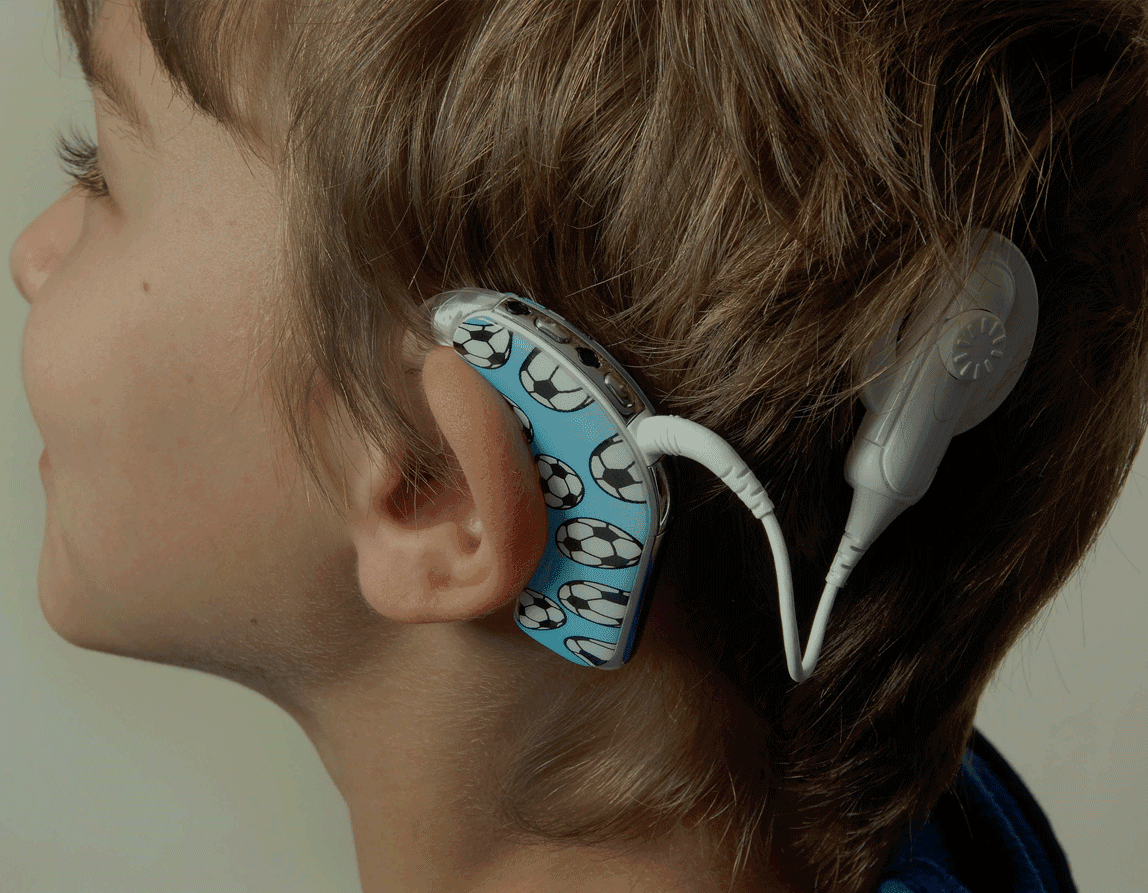
What is a cochlear implant?
An electronic device designed to give partial hearing to people who are profoundly deaf.
The ear has three sections:
- the outer ear (the visible part)
- the middle ear
- the inner ear
Sounds are created when something vibrates.
The outer ear "captures" these vibrations and funnels them into the middle ear.
The middle ear is comprised of the ear drum
and three tiny bones (the "mallus" (hammer), the "incus" (the anvil) and the "stapes" (the stirrup). The vibrations strike the ear drum and the vibration of the ear drum is transmitted by the three bones to the cochlea in the inner ear.
The inner ear has two main parts:
- the semi-circular canal, which is part of the vestibular system (which controls balance)
- the cochlea (for hearing).
The cochlea looks like the coil of a snail shell. It contains many very fine hair cells. These hair cells send impulses to the auditory nerve fibres, which send them on to the brain. The brain interprets these impulses as meaningful sounds.
There are various ways that a person may become deaf. One way is if the hair cells in the cochlea are somehow damaged or not working and cannot send impulses to the auditory nerve fibres.
In many cases, the auditory nerve fibres are still intact and functional, but are not responsive because they are not receiving any impulses from the damaged hair cells.
A hearing aid works by making sounds louder and/or clearer.
However, if the hair cells in the cochlea are severely damaged they are incapable of sending impulses, no matter how loud the sounds are.
Unlike a hearing aid, the cochlear implant "bypasses" the damaged hair cells in the cochlea. It is implanted in the cochlea and serves the function of the hair cells. It sends electrical signals directly to the auditory nerve fibres. These electrical impulses act in a similar way to impulses that normal hair cells send.
There are four parts to a cochlear implant:
- the surgically implanted part – comprising of an implant unit and 24 electrodes
- microphone
- signal (or speech) processor
- transmitter.
- An implant unit and the 24 electrodes are surgically implanted. The electrodes are arrayed within the cochlea itself.
- A microphone is worn outside the body to "capture" sounds and send them to the signal (speech) processor.
- The signal (speech) processor then analyses and translates these sounds into distinctive coded signals that are sent to the transmitter.
- The transmitter sends the coded signals across the skin to the internal implant unit. The implant unit converts these coded signals to electrical signals.
- These electrical signals are sent to the electrodes in the cochlea to stimulate the auditory nerve fibres to send information to the brain. The brain then interprets the signals as meaningful sounds.
- Cochlear implants are particularly beneficial for deaf children who do not benefit from hearing aids or other means of amplification and show a lack of progress in developing auditory skills. The earlier the device is implanted, the greater the benefits that the child is likely to receive. Recent studies have indicated that these benefits include enhanced development and learning ability, even for a second language.
- According to ear doctors, patients whose deafness is due to bilateral nerve deafness (also known as a "sensorineural hearing loss") caused by some inner ear damage or dysfunction, such as damaged hair cells.
- Patients who attain almost no benefit from a hearing aid.
- Patients who have suffered severe to profound hearing loss in adulthood (post-lingual deafness).
- Cochlear implants cannot fully restore normal hearing and the benefits will vary from one person to another. Much depends on how long the person has been deaf and the extent of the damage to the inner ear.
- Most users find that the cochlear implants help them communicate better, with many being able to discriminate speech without visual cues.
- The first step is a surgery to implant the internal implant unit and the electrodes. This normally lasts about two to three hours and is done under general anaesthesia.
- The surgeon will make an incision behind the ear to reach the mastoid bone and then will fit the implant unit into the mastoid bone.
- The surgeon will then carefully drill through the bone to reach the inner ear and make a small opening in the cochlea (the part that looks like the coil of a snail's shell).
- The surgeon will then insert the array of electrodes on a thin flexible "band" that goes inside the coil of the cochlea.
- The ENT surgeon will close the incision behind the ear and the head will be bandaged. The patient is usually discharged on the day of the surgery or the day after it. Most patients recover very well.
- Within about 3 to 5 weeks, the incision will normally heal and the swelling around the implant area will usually go down.
- After the incision has healed, the only visible sign of the implant may be a small bump behind the ear. The hair should grow back to cover any bump so it cannot be easily seen.
A few weeks after the surgery, the external equipment is activated and adjustments are made. The patient is taught how to look after the system and how to listen through it.
Re-adjustment of the signal processor may be required from time to time.
Our Singapore ENT clinic specialises in the end-to-end management of all ear, nose, and throat conditions while keeping the best ENT practices in mind.







